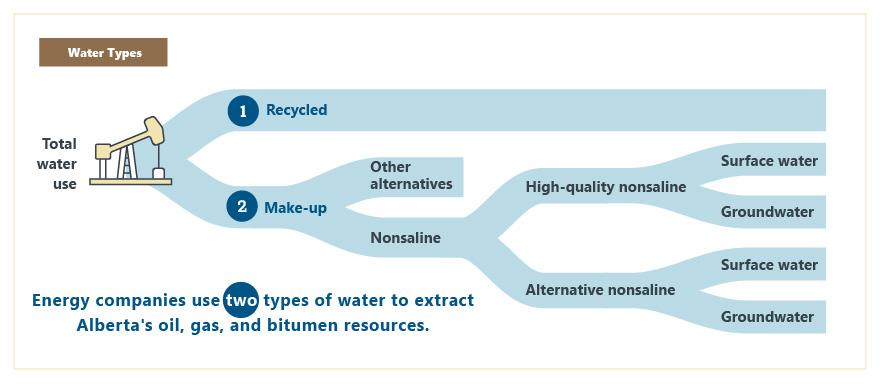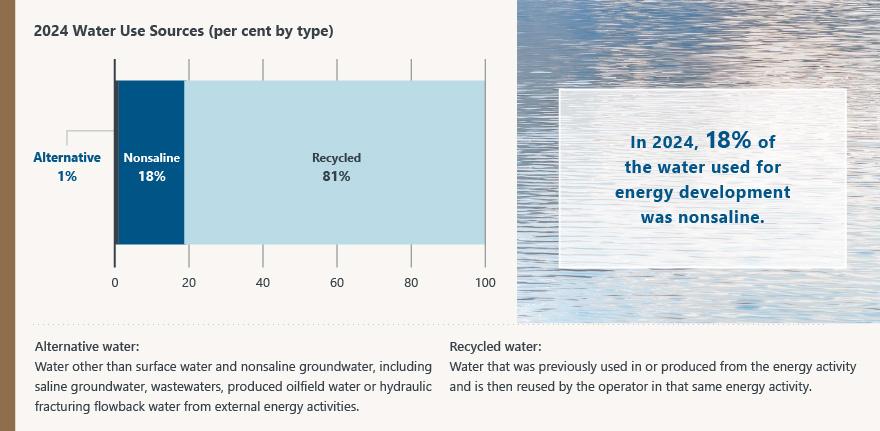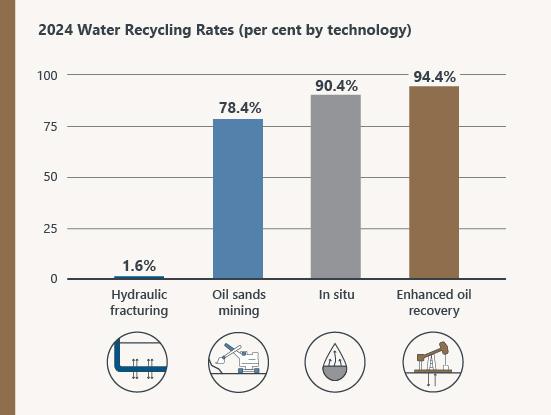October 2025
The following topics discussed on this page:
Water Types
Energy companies use two types of water to extract Alberta's oil, gas, and bitumen resources: recycled water and make-up water. Make-up water is further subdivided to identify the various types of water that can be used.

Recycled Water
Every technology used to recover Alberta's energy resources recycles and reuses water. In this report, reused water is classified as recycled water.
Make-up Water
Water is used in energy extraction and processing for start-up operations or to make up for water lost during water recycling and resource extraction processes. Make-up water is used when companies need more water than can be obtained from recycling.
Make-up water is obtained from nonsaline water sources or alternatives to nonsaline sources (other alternative sources).
Other Alternative Water
Alternatives to nonsaline water include deep saline groundwater and produced water. A Water Act licence is not required to use other alternative water but companies must report how much they use.
Nonsaline Water
Companies must apply for a Water Act licence from the AER before using nonsaline water in their operations. Nonsaline water has a total dissolved solids content of 4000 milligrams per litre (mg/L) or less.
The Water Conservation Policy for Upstream Oil and Gas Operations (WCP) provides direction on water use and conservation in upstream oil and gas operations. The policy emphasizes using alternatives to high-quality nonsaline water sources where feasible.
The AER’s Manual 025: Applications Under the Water Conservation Policy for Upstream Oil and Gas Operations divides nonsaline water into two subcategories: high-quality nonsaline (HQNS) and alternative nonsaline (ANS). Manual 025 supports the WCP objective of conserving high-quality nonsaline water by ensuring reasonable alternative water sources have been assessed for technical and economic feasibility, recognizing that, in some cases, using high-quality nonsaline water may have the lowest overall impact.
Manual 025 applies to oil sand thermal in situ operations, enhanced oil recovery, and multistage hydraulic fracturing operations in horizontal wells. For oil sands mining operations, the WCP provides supplemental guidance to the Lower Athabasca Region: Surface Water Quantity Management Framework for the Lower Athabasca River.
Drilling and completion operations, including hydraulic fracturing in vertical wells, are not in the scope of Manual 025 (although Water Act licences are still required to use nonsaline water for those purposes).
This report categorizes water as high-quality nonsaline water, alternative nonsaline water, and other alternative water to align with the WCP and for comparison between technology sectors.
High-Quality Nonsaline Water
High-quality nonsaline water includes high-quality nonsaline surface water and high-quality nonsaline groundwater.
High-quality nonsaline surface water is sourced from streams, rivers, lakes, springs, wetlands, and manmade water bodies.
Sources of high-quality nonsaline groundwater include
- shallow aquifers, where the top of the aquifer is less than 150 m from the surface,
- aquifers in sediments above bedrock, and
- aquifers in water-short areas.
High-quality nonsaline groundwater instream flow needs or is usable for drinking water supplies and livestock watering with standard treatment technologies.
Alternative Nonsaline Water
Alternative nonsaline water includes surface water and groundwater that is highly mineralized but meets the definition of nonsaline water or was used and adversely affected by industrial, commercial, or municipal activities.
Alternative nonsaline groundwater has a total dissolved solids content of 4000 mg/L or less. It includes relatively deep groundwater that does not directly support instream flow needs. See the figure in the glossary to determine whether nonsaline groundwater is considered “alternative” or “high quality.”
Water Use
Using other alternatives to nonsaline water and improving technology reduces nonsaline water use in energy development. In 2024, 81% of the water used to recover energy resources was recycled, with 18% from nonsaline sources.

Recycle Water Use
The amount of recycled water used varies by extraction technology (see the following figure).

Enhanced oil recovery and in situ operations return large amounts of produced water to the surface, which are frequently recycled into the process. Hence, these extraction technologies have high recycling rates.
Even with a 78% recycling rate, oil sands mining uses the most nonsaline water.
Hydraulic fracturing operators have the lowest rate of recycling water use. Water is used for the initial fracture only and is typically produced during the initial flowback period, resulting in fewer opportunities to recycle water than other extraction technologies.
Nonsaline Water Use
The following figure shows nonsaline water use by extraction technology. It also includes the hydrocarbons produced in barrels of oil equivalent (BOE).
In 2024, the energy industry used about 310 million m3 of nonsaline water, 28% of its water allocation.
Allocations dictate where water can be withdrawn, but water is often used in other areas. Consequently, water use within an area (e.g., HUC8) could exceed the water allocation for that area if it were sourced from elsewhere. Additionally, annual volumes of water used can differ from the annual allocation because water could be stored before use.
The following map shows the actual use of nonsaline water in Alberta in 2024 to extract oil, gas, and bitumen by HUC 8 area.
Water Use Intensity
The volume of water used does not necessarily indicate the level of operational efficiency. The AER considers nonsaline water use intensity as a measure of water use efficiency. Water use intensity is expressed as a ratio of the number of barrels of nonsaline water used to produce one BOE.
The following figure shows water use intensity by extraction technology from 2013 to 2024. Over the past 12 years, all extraction technologies have reduced their water use intensity except hydraulic fracturing, resulting in a 13% decrease in the industry average (purple line in the graph below).
Oil sands mining continues to have the highest water use intensity and in situ the lowest. In oil sands mining, significant improvements were made in water use performance over the past 12 years, with water use intensity decreasing by 19%. Water use intensity for hydraulic fracturing has increased since 2013, correlating with increased drilling activity in the Duvernay and Montney Formations. From 2023 to 2024, the industry average nonsaline water use intensity increased by 1% due to the increased activity in the oil sands mining and hydraulic fracturing sectors.
Find out more about how water is allocated and used among the extraction technologies in the following sections:


